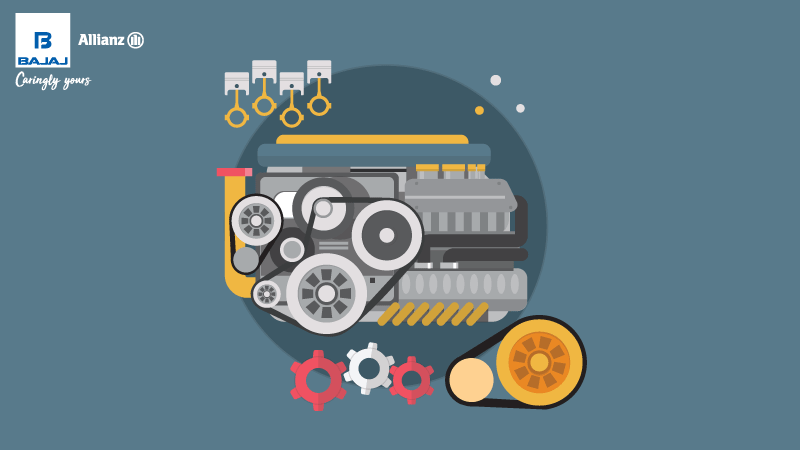When it comes to car insurance plans, many car owners are primarily focused on the basics—collision, comprehensive, and liability coverage. However, when an accident happens, the fine details of what specific car parts are covered under your insurance policy become critically important. This blog will get into the details of the components of auto insurance related to car parts and accessories, guiding you through what is generally covered under standard policies, including the special bumper-to-bumper coverage, and how you can ensure more comprehensive protection with additional covers like those for consumables.
Key Components of Auto Insurance
Explore the essential elements of auto insurance, from collision and comprehensive coverage to liability protection.
Collision Coverage:
This part of your insurance kicks in when your car is damaged due to a collision with another vehicle or object. It typically covers the repair or replacement of damaged parts like the front and rear bumpers, doors, and hoods.
Comprehensive Coverage:
Unlike collision coverage,
comprehensive insurance covers damage to your car caused by non-collision incidents such as theft, fire, vandalism, and natural disasters. It helps pay for damages to the windshield, wheels, and even the engine in some cases.
Liability Coverage:
This is a mandatory cover in many regions and pays for damages and injuries you cause to others in an accident. It does not cover any of your car's parts but is crucial for your financial protection against claims from third parties.
”
Also Read: Third-Party Liability Insurance Coverage”
Car Accessories and Parts Insurance
Not all parts of your car may be covered under the standard collision or comprehensive policies. Here’s where specific add-ons like the bumper-to-bumper policy come into play.
Bumper-to-Bumper Policy
Also known as a
zero depreciation policy, bumper-to-bumper insurance offers comprehensive coverage without factoring in the depreciation of your car parts. This means if you have an accident, the insurance will cover the costs of the car parts at their actual value without considering age or wear and tear. This is particularly useful for expensive components like the gearbox, engine parts, and electronics, which otherwise could attract significant deductions when claimed under standard policies.
Car Parts Insurance Cover
Standard policies might not cover every part of your car or might only offer partial coverage depending on the age and depreciation of your vehicle. Here are some car parts and situations typically covered under a comprehensive car insurance plan
:
- Engine Parts: Includes coverage for damages to the engine from accidents but not from wear and tear or mechanical failures.
- Electrical Components: Some policies cover electrical components like your car’s stereo system, but check if you need additional coverage for high-end electronics.
- Windshields and Windows: Usually covered under comprehensive insurance if damaged by events like storms or vandalism.
- Tyres: Tyres might only be covered if the damage is caused by an accident covered under the policy. Damage due to regular wear or punctures may not be included.
Consumables Add-On Cover
A standard auto insurance policy does not cover consumables—small but essential items that could be costly over time. These include:
- Engine Oil, Coolant, and Other Fluids: These are necessary for your car’s daily operation but need regular replenishment and changes.
- Nuts, Bolts, and Washers: Small components that might be replaced during repair after an accident.
- Filters and Bearings: Includes air filters, oil filters, and fuel filters.
The consumables add-on is a must if you want these smaller parts covered, as they are often used up and cannot be salvaged once your vehicle is repaired.
Exclusions and Limitations
While choosing additional coverage like a
bumper-to-bumper policy or consumables add-on can give you extensive protection, be aware of the exclusions. These often include:
- Wear and Tear: Gradual deterioration of car parts due to normal usage is typically not covered.
- Mechanical Breakdowns: Issues arising from inherent mechanical problems in the car are not covered unless specified in the policy.
- Driving Under Influence: Any damage incurred while the driver was under the influence of drugs or alcohol is excluded from coverage.
Why Opt for Comprehensive Car Parts Insurance?
Investing in a
comprehensive car insurance plan with appropriate add-ons for consumables and zero depreciation ensures that you are not caught off guard by unexpected repair costs. Moreover, it provides peace of mind knowing that from small components like nuts and bolts to significant parts like your engine and transmission, everything is protected.
Understanding what your
Car Insurance Covers in terms of parts and accessories is crucial for every car owner. By knowing the components of your auto insurance and opting for additional coverage where necessary, you can ensure that you are fully protected in any situation. Always read the fine print of your policy and discuss with your insurance provider to make sure all critical parts of your car are covered, helping you to drive stress-free.
*Standard T&C Apply
‘Insurance is the subject matter of solicitation. For more details on benefits, exclusions, limitations, terms and conditions, please read sales brochure/policy wording carefully before concluding a sale.’
 Service Chat:
Service Chat: 

